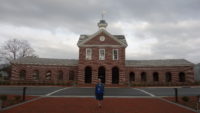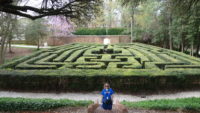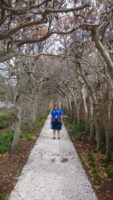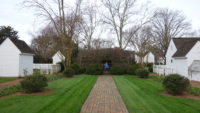 People make much of history, so it is no surprise that I have found interacting with people in Williamsburg to be the most satisfying part of the day. Whether it be tradesmen, guides, historical interpreters, archeologists, or impersonators playing famous people, I have found the people of Colonial Williamsburg to be friendly, interesting, and engaging.
People make much of history, so it is no surprise that I have found interacting with people in Williamsburg to be the most satisfying part of the day. Whether it be tradesmen, guides, historical interpreters, archeologists, or impersonators playing famous people, I have found the people of Colonial Williamsburg to be friendly, interesting, and engaging.
We got to the museum today just as they opened, and we went right to the governor’s palace to get a chance to see inside. Even though we got there right at 9:00, there were already over ten people in line, so we had a fifteen-minute wait or so, which was fine since we had an in-costume interpreter there giving us some background on not only the palace, but some of the neighboring houses as well. For instance, the next house down the street was owned by a man with many slaves; after the war was over, he could not justify fighting for liberty while still owning other human beings, so he freed all of his slaves. This didn’t go over well with the rest of the community, and he finally moved to Maryland.
 Once we got into the palace, we got to go through the three main ground floor rooms, as well as look into the side rooms. Sadly, because of Covid restrictions, we were not allowed to go upstairs. The entrance hall and the next room were covered in muskets and swords so as to leave no doubt about who was in charge. Until he wasn’t. In January of 1775, the governor was a hero, having fought off Native Americans in the Ohio valley. But by June of 1775, public opinion had turned so much against him that he sneaked out of the palace back door at 2:00 am, never to return.
Once we got into the palace, we got to go through the three main ground floor rooms, as well as look into the side rooms. Sadly, because of Covid restrictions, we were not allowed to go upstairs. The entrance hall and the next room were covered in muskets and swords so as to leave no doubt about who was in charge. Until he wasn’t. In January of 1775, the governor was a hero, having fought off Native Americans in the Ohio valley. But by June of 1775, public opinion had turned so much against him that he sneaked out of the palace back door at 2:00 am, never to return.
I was happy to see the inside of the palace, which was elegant, but I was equally happy that I had not waited an hour for the ten-minute tour. I applaud Colonial Williamsburg for their being open during a pandemic, and taking precautions seriously, but it does cause a long (and well-spaced) line at the most popular attractions.
 We did much the same with the nearby Wythe House. Wythe was a prominent lawyer and leader of the community who tutored a young Thomas Jefferson in the law. His home is open, but only the downstairs rooms, so our twenty-minute wait led to an eight-minute tour. But it dumped us into the garden, where in one building were three coopers working. We chatted with them for five or six minutes, which was an unexpected encounter.
We did much the same with the nearby Wythe House. Wythe was a prominent lawyer and leader of the community who tutored a young Thomas Jefferson in the law. His home is open, but only the downstairs rooms, so our twenty-minute wait led to an eight-minute tour. But it dumped us into the garden, where in one building were three coopers working. We chatted with them for five or six minutes, which was an unexpected encounter.
Since the Wythe House was our last house we could tour, we went back to the palace gardens to kill some time. The gardens are in full bloom with tulips, which only last a few weeks, so our timing was good. We sat on a bench on top of the old ice house mound, which overlooks the shrubbery maze, and we amused ourselves watching people wandering back and forth.
Next was a rare (in these times) treat – we got to see some theater. There is a small stage near the palace, and we got to see a twenty-minute condensed version of Bach’s “Coffee Cantata,” in which a young woman who is addicted to coffee rejects three suitors who try to convert her to (in order) beer, tea, and water. It was light-hearted and fun, and was only the second play we have seen of any kind in over a year (the other being CVCA’s fall play).
 The short length of the play gave us time to walk to the other stage in town, over by the capitol building. We got to see an impersonator be George Wythe himself, and the actor was amazing. His voice was rich, his pacing was deliberate, his command of the material was impressive, and his ability to stay in character for the questions at the end was mesmerizing. He spoke for about thirty minutes, and I felt I could have happily listened to him for an hour. He spoke on the four points of law (municipal, national, scriptural, and natural law, in that order), and tied that in to the need to teach and model virtue for the sake of the republic. He interacted with the audience frequently, always in character. It was a masterly performance, and I was thrilled to get to see it.
The short length of the play gave us time to walk to the other stage in town, over by the capitol building. We got to see an impersonator be George Wythe himself, and the actor was amazing. His voice was rich, his pacing was deliberate, his command of the material was impressive, and his ability to stay in character for the questions at the end was mesmerizing. He spoke for about thirty minutes, and I felt I could have happily listened to him for an hour. He spoke on the four points of law (municipal, national, scriptural, and natural law, in that order), and tied that in to the need to teach and model virtue for the sake of the republic. He interacted with the audience frequently, always in character. It was a masterly performance, and I was thrilled to get to see it.
After a brief stop in the Williamsburg garden (to talk to the gardeners), lunch was next, which for the third day in a row was at the Williamsburg art museums (they combine a folk art museum with a design museum). That put us next to the last sight we needed to see – an active archeological excavation of the grounds of a wealthy man who was reported as having the best gardens in all of Virginia. We spoke with three of the archeologists on site, and while they are interested in anything they might find, the long-term goal is to discover the old garden beds and what was planted in them, so as to be able to recreate the garden. We got to hear how they looked for discolored dirt in the digs, which indicated that area had been dug up at some point, and they followed those trails. They are in year three of a five-year dig, so they have plenty of additional ground to cover. That is good, since one of the scientists was on day four of digging along a soil trail about three feet long, and had found nothing as yet.
We also chatted on our way out with a friendly young man who was in costume. We talked about the dig, about eighteenth-century sanitation, about the owner of the land and his publicly cantankerous marriage, and about the Facebook group on eighteenth-century clothing. As one does. We like nerds. They are always interesting.
By then, it was about 2:30, and the long-anticipated rain finally started falling, so we made our way into the museum. I overheard there was a musician playing, so we found him and listened to him play the viola da gamba for about twenty minutes, and we got to ask him questions. The viola da gamba is a cousin to the cello, except it has seven strings (instead of four) and is supported by the musician’s legs (instead of a post on the bottom of the cello). So we got to experience theater and live music on the same day.
The museums looked quite fine, especially for a regional museum, but as I was tired, we kind of hurried through them. I did like the exhibit on grandfather clocks, which included the gear mechanisms. We also both liked an exhibit on American portrait painters, which helped even our untrained eyes see the difference between good painters and great painters. Mer also pointed out a sign saying that hooked rugs are arguably the only original American folk art, and they came from Maine. I remember seeing hooked rugs around in my youth in Maine, although I feel braided rugs were more common.
Day three of Williamsburg was a fine day, with lots of interaction with people. If it were a normal year with all the buildings fully open, I expect we would need to be going back for a fourth day, but maybe we can save that for later in this year. For now, for us, Colonial Williamsburg is history.
Love the Coffee Cantata. Wasn’t too abridged- the cantata isn’t long!